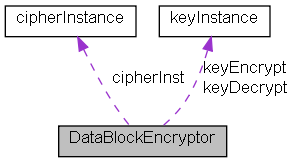Encrypts and decrypts data blocks. More...
#include <DataBlockEncryptor.h>

Public Member Functions | |
| DataBlockEncryptor () | |
| ~DataBlockEncryptor () | |
| bool | IsKeySet (void) const |
| void | SetKey (const unsigned char key[16]) |
| Set the encryption key. | |
| void | UnsetKey (void) |
| Unset the encryption key. | |
| void | Encrypt (unsigned char *input, unsigned int inputLength, unsigned char *output, unsigned int *outputLength, RakNetRandom *rnr) |
| Encryption adds 6 data bytes and then pads the number of bytes to be a multiple of 16. | |
| bool | Decrypt (unsigned char *input, unsigned int inputLength, unsigned char *output, unsigned int *outputLength) |
| Decryption removes bytes, as few as 6. | |
Protected Attributes | |
| keyInstance | keyEncrypt |
| keyInstance | keyDecrypt |
| cipherInstance | cipherInst |
| bool | keySet |
Detailed Description
Encrypts and decrypts data blocks.
Definition at line 18 of file DataBlockEncryptor.h.
Constructor & Destructor Documentation
| DataBlockEncryptor::DataBlockEncryptor | ( | ) |
Definition at line 17 of file DataBlockEncryptor.cpp.
| DataBlockEncryptor::~DataBlockEncryptor | ( | ) |
Definition at line 22 of file DataBlockEncryptor.cpp.
Member Function Documentation
| bool DataBlockEncryptor::Decrypt | ( | unsigned char * | input, | |
| unsigned int | inputLength, | |||
| unsigned char * | output, | |||
| unsigned int * | outputLength | |||
| ) |
Decryption removes bytes, as few as 6.
Output should be large enough to hold this. Output can be the same memory block as input
- Parameters:
-
[in] input the input buffer to decrypt [in] inputLength the size of the input buffer [in] output the output buffer to store decrypted data [in] outputLength the size of the output buffer
- Returns:
- False on bad checksum or input, true on success
Definition at line 127 of file DataBlockEncryptor.cpp.


| void DataBlockEncryptor::Encrypt | ( | unsigned char * | input, | |
| unsigned int | inputLength, | |||
| unsigned char * | output, | |||
| unsigned int * | outputLength, | |||
| RakNetRandom * | rnr | |||
| ) |
Encryption adds 6 data bytes and then pads the number of bytes to be a multiple of 16.
Output should be large enough to hold this. Output can be the same memory block as input
- Parameters:
-
[in] input the input buffer to encrypt [in] inputLength the size of the input buffer [in] output the output buffer to store encrypted data [in] outputLength the size of the output buffer
Definition at line 44 of file DataBlockEncryptor.cpp.

| bool DataBlockEncryptor::IsKeySet | ( | void | ) | const |
- Returns:
- true if SetKey has been called previously
Definition at line 25 of file DataBlockEncryptor.cpp.

| void DataBlockEncryptor::SetKey | ( | const unsigned char | key[16] | ) |
Set the encryption key.
- Parameters:
-
[in] key The new encryption key
Definition at line 30 of file DataBlockEncryptor.cpp.


| void DataBlockEncryptor::UnsetKey | ( | void | ) |
Unset the encryption key.
Definition at line 39 of file DataBlockEncryptor.cpp.

Member Data Documentation
cipherInstance DataBlockEncryptor::cipherInst [protected] |
Definition at line 62 of file DataBlockEncryptor.h.
keyInstance DataBlockEncryptor::keyDecrypt [protected] |
Definition at line 61 of file DataBlockEncryptor.h.
keyInstance DataBlockEncryptor::keyEncrypt [protected] |
Definition at line 60 of file DataBlockEncryptor.h.
bool DataBlockEncryptor::keySet [protected] |
Definition at line 63 of file DataBlockEncryptor.h.
The documentation for this class was generated from the following files:
 1.7.1
1.7.1